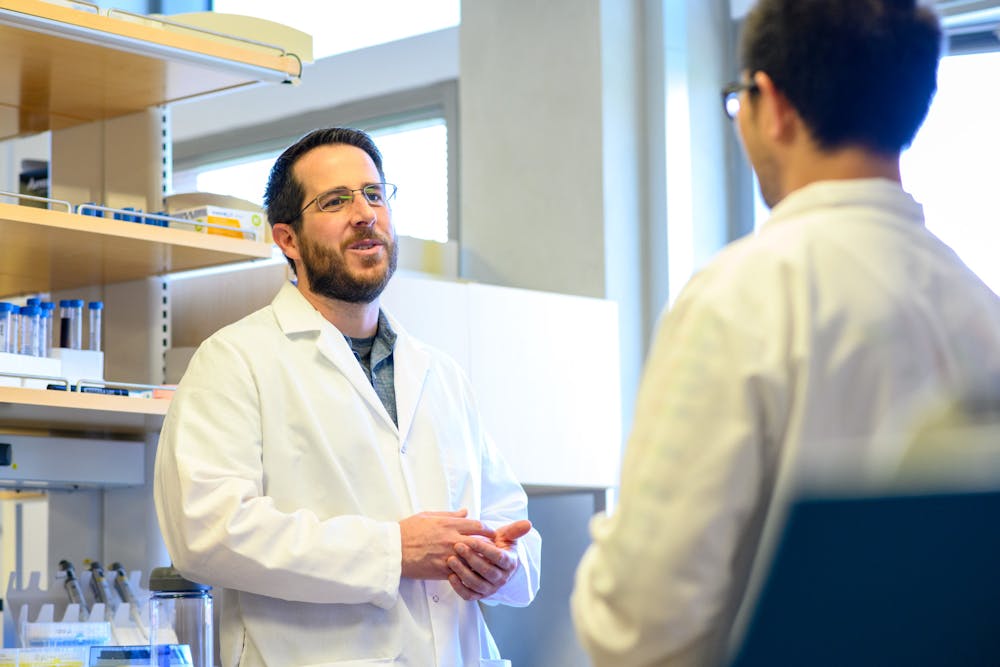The COVID-19 pandemic tested governments, basic research scientists and pharmaceutical industries worldwide, forcing administrations, labs and companies to accelerate and innovate their research at warp speed. Each extra day it took for a treatment or vaccine to reach patients meant more pandemic-related casualties. One crucial factor in vaccine development was the race to understand the viral spike protein of SARS-CoV-2, a crucial viral surface component required for viral entry which had long been touted as a potential target for coronavirus vaccines.
Jason McLellan (Hopkins BCMB Ph.D. ‘09), a professor of molecular biosciences and the Welch Chair in Chemistry at The University of Texas at Austin, had worked to resolve the structure of a coronavirus spike protein in 2016, years before the pandemic began. Due to their prior experience with coronavirus spike proteins, McLellan’s team was able to rapidly respond to the pandemic, publishing the structure of the SARS-CoV-2 spike protein in February 2020 and designing stabilized spike proteins by June 2020 for vaccine development.
“During that stabilization we did back in 2016, we were… sort of anticipating [the pandemic],” McLellan explained. “There was a SARS outbreak in China in 2002 and a MERS outbreak in Saudi Arabia in 2012, so we thought, ‘we've had two big spillovers 10 years apart. There's going to be another one. We should really start working on coronaviruses and figuring them out.’”
Though McLellan was able to resolve the structure of some conformations of the coronavirus spike protein, the inherent instability of some of the protein’s other conformations posed a challenge requiring protein engineering.
“Some of these proteins we work on… like coronavirus spike protein, are shape shifters. They exist in pre- and post-fusion states,” McLellan detailed. “Generally, the pre-fusion state is the better vaccine immunogen. It contains all the neutralizing epitopes, but it’s also metastable. So we had to engineer the protein so it stayed in pre-fusion as you inject it into somebody’s arm and as it goes to germinal centers for antibody elicitation.”
In order to stabilize the spike protein, McLellan replaced two specific amino acid residues with proline, a nonpolar amino acid containing a cyclic side chain that restricts the conformational flexibility of alpha helices and thus inhibits the transition from the pre-fusion to the post-fusion conformation.
“We came up with where to put stabilizing proline substitutions in [coronavirus] spike proteins. So when [the genome sequence of] SARS-CoV-2, the causative agent of COVID-19 disease, was made available, we knew where to put our stabilizing protein [substitutions], and those are found in all the COVID-19 vaccines authorized for use in the US.”
Due to this rapid basic science response to the pandemic, McLellan was recently awarded a MacArthur Fellowship, an $800,000, no-strings-attached “genius grant” given to around 20 exceptional individuals per year. Previous recipients include Hamilton playwright Lin-Manuel Miranda, science-fiction novelist Octavia Butler and number theorist Yitang Zhang.
“[20-30] people each year get [MacArthur Fellowships]. They're interesting in that they're not purely science… but span a lot of creative types – arts and humanities,” McLellan said. “I think this recognition is nice for the field, for our consortium of people who work together.”
Beyond being a recognition for the field of vaccine research and basic science at large, the no-strings-attached monetary value of the award directly benefits McLellan’s future research.
“It comes with a pretty substantial amount of money… and it allows more freedom,” McLellan said. “We can pursue some higher risk studies, or we can start generating the preliminary data that we need in order to get grants… [it] helps buffer us from any funding issues.”
The experience that McLellan’s team gained from the COVID-19 pandemic, along with the MacArthur fellowship, has allowed them to continue increasing their efforts researching vaccine design using structural biology.
“We're still really pushing and trying to expand and innovate for structure-based vaccine design,” McLellan said. “Structural biology provides good basic science questions about what these viral proteins or protein complexes look like, how they find receptors and what conformational changes lead to entry.”
Using the structural information gained from studying the wild type protein, McLellan is able to use protein engineering to make modified versions, stable complexes and soluble versions of the protein to produce potent monoclonal antibodies. These stable antibodies can then be used to guide vaccine design, with the goal of creating vaccine antigens that will elicit a patient’s production of highly protective antibodies against specific viruses.
“[We were] led to this paradigm of pandemic preparedness and prototype pathogens, working on things and trying to understand general rules for that viral family,” McLellan explained. “So even if what you're working on isn't the exact virus that spills over, maybe you already know how best to make viruses for a particular viral family, and then you can translate that really quickly.”
In the future, McLellan’s research seeks to structurally understand not only viruses, but also bacteria and fungi, and use knowledge gained from basic research to prepare for potential future pandemics.
“Now we're doing a lot in pandemic preparedness, working on things a lot of people haven't heard of: BSL 3, BSL 4 pathogens, things that might one day cause a pandemic,” McLellan said. “And we want to have all that research — structures and stabilization — done beforehand, so we can again rapidly roll out a vaccine if one of these things starts to really spread.”
McLellan attributes these discoveries in structural biology and vaccine development to his scientific mindset, in which he pushes himself and his team to constantly come up with new ideas and experiments.
“One key to success I tell my students is ‘work hard, be smart and get lucky.’ The more hours you're in lab, the more projects you're juggling, the more likely one of them leads to a big finding,” McLellan advised. “Really know the literature… so when you stumble across something, you recognize it… There’s also a creative aspect of science, so you need to be relaxed: you need to have time to just dream up and experiment and really think about the data.”





